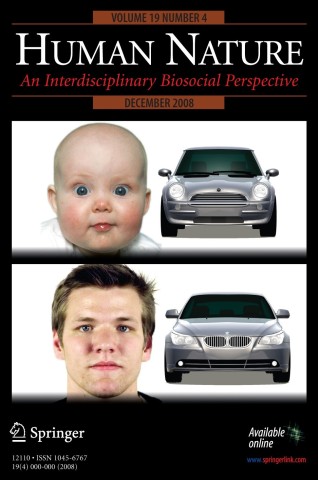- Manufacturer: Volvo Car Corporation
- Material: polycarbonate
- Dimensions: 70 × 34 × 9
- www.volvo.com
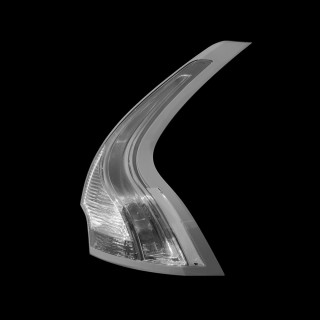
Index
- Volvo Group The Volvo Group is a Swedish supplier of commercial vehicles such as trucks, buses and construction equipment, drive systems for marine and industrial
- Light Emiting Diode A light-emitting diode (LED) is an electronic light source. LEDs are used as indicator lamps in many kinds of electronics and increasingly for lightin
- LED Lamps Tolomeo LED Tolomeo LED My White Light combines the advantages of LED technology with those of My White Light technology, enabling numerous variations
- LED Tail Lights LED vs Incandescent LEDs have several advantages over conventional incandescent lamps. For one thing, they don't have a filament that will burn out, s
- Polycarbonate Polycarbonates are a particular group of thermoplastic polymers. They are easily worked, moulded, and thermoformed; as such, these plastics are very w
- XC60 Safety City Safety Volvo has just come out with its own version of collision detection technology, calling it "City Safety," and aims to release this new fea
- Car Faces Human Or Animal Faces Associated With At Least 90 Percent Of Cars By One-Third Of Population Do people attribute certain personality traits or emotion
The Volvo Group is a Swedish supplier of commercial vehicles such as trucks, buses and construction equipment, drive systems for marine and industrial applications, aerospace components and financial services. Although Volvo was incorporated in 1915 as a subsidiary of AB SKF, a Swedish ball bearing manufacturer, the auto manufacturer was officially founded on 14 April 1927, when the first car rolled out of the factory in Hisingen, Gothenburg.
Volvo means "I roll" in Latin, conjugated from "volvere" (cp the ball bearing producer SKF). The name Volvo was originally registered in May 1911 as a separate company within SKF AB and as a registered trademark with the intention to be used for a special series of ball bearing, but this idea was only used for a short period of time and SKF decided to use "SKF" as the trademark for all its bearing products. In 1924, Assar Gabrielsson, a SKF Sales Manager, and Engineer Gustav Larson, the two founders, decided to start construction of a Swedish car. Their vision was to build cars that can withstand the rigors of Sweden's rough roads and cold temperatures. This has become a feature of Volvo products ever since.
In 1999 Volvo sold its car division Volvo Cars to Ford for $6.45 billion. Repeated reports in the media about Ford selling off Volvo Cars have been refuted by the company. However, on 1 December 2008, Ford announced that it will "re-evaluate its strategic options for Volvo," including the possible sale of the marque. In 2009 Ford Motor Company has confirmed its preference to Chinese motor manufacturer Geely in the acquisition of Volvo.
Design Chief
Peter Horbury is a British car designer currently in charge of all design for Volvo Cars . He is probably best known for his design work for Volvo where he was Design Director during 1991 to 2002. He was named UK magazine Autocar's Designer of the Year in 1998 and during his 30+year career has been actively involved in the design of more than 50 cars as well as trucks, buses and motorcycles.
Horbury is best known for leading the revival of the Volvo brand during his eleven years from 1991 as Design Director. He arrived too late to influence the 1992 Volvo 850 but made an immediate impact with his 1992 Volvo ECC Concept that would influence Volvo design for years to come. He was instrumental in ditching their traditional boxy look in favour of creating and implementing a stylish new design language for the brand.[3][4] This stylish new look was characterised by distinctive shoulder-lines that ran the length of the car, more curved surfaces, rounded noses, and softer, less utilitarian interiors. He contributed to many designs including the Mitsubishi Carisma related 1995 S40 and V40, the sporty 1997 Volvo C70, which was engineered in collaboration with TWR, closely followed by the 1998 S80. He also contributed to the remaining line up with the 2000 V70 estate, the 2001 S60, the 2003 XC90 SUV, and the 2004 S40 and V50. He also oversaw the 1998 facelift of the Volvo 850 series which transformed them into the Volvo S70 and V70 series. Horbury's last Volvo was the 2006 C30.[5] Ex-Mercedes-Benz designer Steve Mattin assumed the responsibility of Design Director of Volvo in 2005. But in the year 2009 he came back by Volvo Cars.
Biography
Born c.1950 in Alnwick, England, Horbury attended King Edward VII School in Sheffield[1] and was coincidentally in the same school year as another prominent British car designer, Ford of Europe's current Executive Director of Design Martin Smith. Horbury went on to study at the Newcastle upon Tyne College of Art, graduating in 1972 with a degree in Industrial Design. Like Smith, he later attended the Royal College of Art in London graduating with a Master's degree in automotive design in 1974.
A light-emitting diode (LED) is an electronic light source. LEDs are used as indicator lamps in many kinds of electronics and increasingly for lighting. LEDs work by the effect of electroluminescence, discovered by accident in 1907. The LED was introduced as a practical electronic component in 1962. All early devices emitted low-intensity red light, but modern LEDs are available across the visible, ultraviolet and infra red wavelengths, with very high brightness.
LEDs are based on the semiconductor diode. When the diode is forward biased (switched on), electrons are able to recombine with holes and energy is released in the form of light. This effect is called electroluminescence and the color of the light is determined by the energy gap of the semiconductor. The LED is usually small in area (less than 1 mm2) with integrated optical components to shape its radiation pattern and assist in reflection.
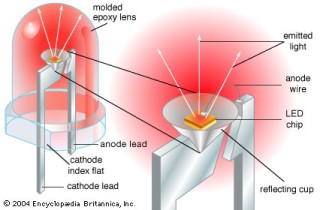

Tolomeo LED
Tolomeo LED My White Light combines the advantages of LED technology with those of My White Light technology, enabling numerous variations of white light to be obtained, with different intensities and varieties of colour temperature, with a range from 3,200K (warm light) to 10,000K (cold light).
Interchangeable support: table base, clamp or desk fixed support.
Materials: base and cantileveredarms in polished aluminium; diffuser in matt anodised or polished aluminium; joints and supports in polished aluminium. System of spring balancing.
Michele de Lucchi, Giancarlo Fassina
Artemide
2009
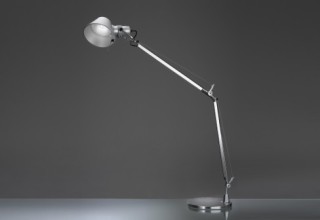
- www.stylepark.com/en/artemide/tolomeo-led-mwl
- www.stylepark.com/db-images/cms/artemide/img/p292287_488_336-1.jpg
El.E.Dee
El.E.Dee is an innovative LED-lamp by Ingo Maurer. This sets new yardsticks based on its trend setting technology in the form of a LED-board as the light resource. 204 LEDs gleam together. A electric transformer with Touch Tronic technology belongs to the delivery content of the El.E.Dee. By the use of a integrated ball joint in the lamp pedestal, the lamp can be turned and bent towards every direction.
Ingo Maurer
2001
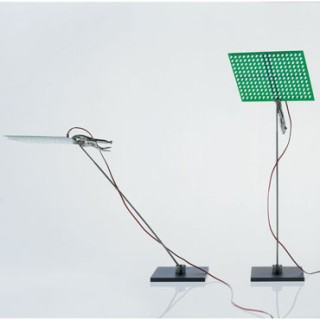
- www.artelight.co.uk/en/interior-lights/table-lamps/ingo-maurer-el-e-dee.html
- www.arredo.co.uk/admin/uploads/ELp21244203101.E.DEE.jpg
Leaf Lamp
"A new experience in light is what we hoped for," says Yves Behar, designer of the Leaf personal light for Herman Miller. As a result of innovative engineering and design development, Behar's hopes became reality.
Leaf offers maximum lighting options with minimal mass in an intriguing, organic form and with controls that invite human connection. The proprietary technology also addresses the most vexing problems in existing LED solutions--light intensity and heat build-up.
Yves Behar
Herman Miller
2006
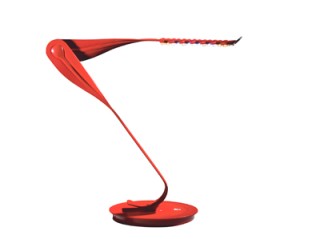
LED vs Incandescent
LEDs have several advantages over conventional incandescent lamps. For one thing, they don't have a filament that will burn out, so they last much longer. Additionally, their small plastic bulb makes them a lot more durable. They also fit more easily into modern electronic circuits.
In conventional incandescent bulbs, the light-production process involves generating heat (the filament must be warmed). Wich represents a waste of energy, unless you're using the lamp as a heater, because a huge portion of the available electricity isn't going toward producing visible light. LEDs generate very little heat, relatively speaking. A much higher percentage of the electrical power is going directly to generating light, which cuts down on the electricity demands considerably.
LED in Brake Lights
They offer extreme vibration resistance, long life and fast switching times, LEDs have been used for automotive high-mounted brake lights and truck and bus brake lights and turn signals for some time, but many vehicles now use LEDs for their rear light clusters. The use of LEDs also has styling advantages because LEDs are capable of forming much thinner lights than incandescent lamps with parabolic reflectors. The significant improvement in the time taken to light up (perhaps 0.5s faster than an incandescent bulb) improves safety by giving drivers more time to react. It has been reported that at normal highway speeds this equals one car length increased reaction time for the car behind.
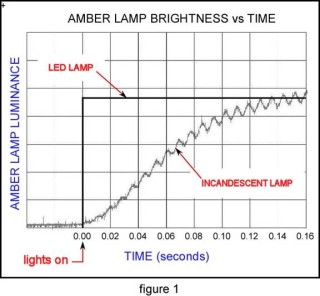
Volvo XC60 Bright Lights
Polycarbonates are a particular group of thermoplastic polymers. They are easily worked, moulded, and thermoformed; as such, these plastics are very widely used in the modern chemical industry. Their interesting features (temperature resistance, impact resistance and optical properties) position them between commodity plastics and engineering plastics. Their plastic identification code is 7.
Clear polycarbonate is used to make eyeglasses because of its excellent transparency, durability, and high infraction index. This means that it bends light to a far greater degree than glass or other plastics of equal thickness. Since prescription lenses bend light to correct vision, polycarbonate lenses can be far thinner than glass or conventional plastic, making polycarbonate the ideal material for heavy prescriptions. Thin polycarbonate lenses correct poor vision beautifully without distorting the face or the size of the eyes, yet this extremely thin lens is virtual indestructible, an important safety factor for children and active adults.
Polycarbonate is also used in the electronics industry. Apple's original iMac featured polycarbonate mixed with clear colors for a transparent computer case. Many cell phones, pagers, and laptops also use clear or opaque polycarbonate in their casings.
City Safety
Volvo has just come out with its own version of collision detection technology, calling it "City Safety," and aims to release this new feature on some models within two years. The technology works via an optical radar in the upper windshield that calculates the distance and speed of the car immediately ahead of you (and it does it 50 times per second), then engages the brakes accordingly if the system detects that a crash is imminent. Of course, Toyota came out with a similar setup that was announced back in August, but Volvo's apparently has the added benefit of being able to "steer away from a potential collision" as well. We weren't really into the idea of turning over braking control to computers at first, either, but steering? We'll stick to walking, thanks.
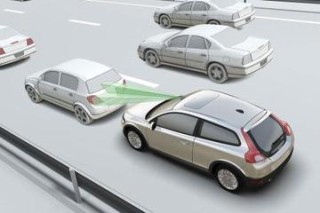
Traffic Safety Achievement Award
"At this year's World Traffic Safety Symposium held at the New York International Auto show, a panel of experts consisting of traffic safety specialists from institutions such as the Department of Transportation and the National Highway Traffic Safety Administration (NHTSA) reward various developments that reduce the number of injuries and fatalities on American roads. Volvo's safety feature, City Safety, made a huge impression on the jury members owing to its ability to prevent or lessen the severity of collisions at low speeds, thus reducing the risk of personal injuries and damage to vehicles.
"Volvo offers this type of feature as standard equipment," says Arp. "City Safety clearly signals that the new XC60 is one of the safest cars Volvo has ever produced. The car is packed with our accumulated safety know-how and technology, both when it comes to helping to prevent accidents and protecting all the occupants in a collision."
XC60 Crash Test Video
Volvo Safety Concept Car
After launching three new car models in 2000, Volvo Cars is now taking a major step further into the future. The main theme of the Volvo Safety Concept Car (SCC) is "superior vision". However, the car also employs a variety of technologies that enhance personal security and improve passive safety systems. The SCC thus points the way to a new dimension in research and development into car safety.
The Volvo SCC is built for the eye — not in terms of aesthetics alone, but because the car has been designed around the driver's eye to ensure better vision and visability.
The Volvo SCC also automatically sets the right driving position, regardless of the driver's build, based on the position of the eyes. When the driver gets in the car, IR sensors and cameras sense the position of the driver's eyes and put the driver's seat in the position that offers optimal visibility. The steering wheel, floor, pedals and centre console are then adjusted to provide the best possible ergonomics and comfort. The driver thus enjoys the best overview of what is happening both outside the car and on the instrument panel.
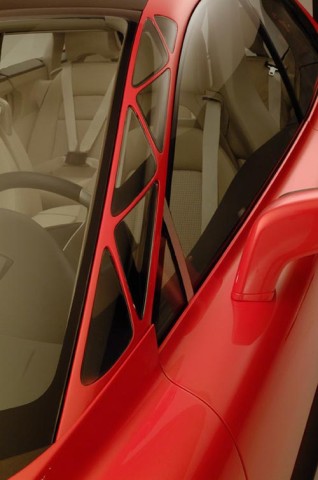

Human Or Animal Faces Associated With At Least 90 Percent Of Cars By One-Third Of Population
Do people attribute certain personality traits or emotions to car fronts? If so, could this have implications for driving and pedestrian behavior? Truls Thorstensen (EFS Consulting Vienna), Karl Grammer (Ludwig Boltzmann Institute for Urban Ethology) and other researchers at the University of Vienna joined economic interest with evolutionary psychology to answer these questions.
The research project investigates our perception of automotive designs, and whether and how these findings correspond to the perception of human faces.
Throughout evolution, humans have developed an ability to collect information on people's sex, age, emotions, and intentions by looking at their faces. The authors suggest that this ability is probably widely used on other living beings and maybe even on inanimate objects, such as cars. Although this theory has been proposed by other authors, it has not yet been investigated systematically. The researchers therefore asked people to report the characteristics, emotions, personality traits, and attitudes that they ascribed to car fronts and then used geometric morphometrics to calculate the corresponding shape information.
One-third of the subjects associated a human or animal face with at least 90 percent of the cars. All subjects marked eyes (headlights), a mouth (air intake/grille), and a nose in more than 50 percent of the cars. Overall, people agreed which type of car possesses certain traits. The authors found that people liked cars most which had a wide stance, a narrow windshield, and/or widely spaced, narrow headlights. The better the subjects liked a car, the more it bore shape characteristics corresponding to high values of what the authors termed "power", indicating that both men and women like mature, dominant, masculine, arrogant, angry-looking cars.
If these are the traits that people like, does that necessarily mean that this is the type of car they would buy? The authors surmise that this might not always be the case. Do we judge a car by our (perhaps stereotyped) impression of its owner, or do we choose a car based on its communication of desired characteristics? Do we feel that driving a car that looks arrogant and dominant might be of benefit in the daily "battles" on the road? These are interesting questions for car manufacturers and researchers alike, and will be pursued further in the collaboration between EFS Consulting and Karl Grammer's group.
The collaborators conclude, "we show that distinct features in the car fronts correspond to different trait attributions. Thus, humans possibly interpret even inanimate structures in biological terms, which could have implications for driving and pedestrian behavior. With respect to practical applications, a tool for automobile designers to style cars according to a desired image could be derived."
